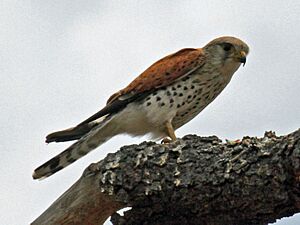Malagasy kestrel facts for kids
Quick facts for kids Malagasy kestrel |
|
|---|---|
 |
|
| Conservation status | |
| Scientific classification | |
| Genus: |
Falco
|
| Species: |
newtoni
|
| Subspecies | |
|
|
The Malagasy kestrel (Falco newtoni) is a small bird of prey. It is also known as the Madagascar kestrel. People sometimes call it Newton's kestrel. This name honors Edward Newton, a British bird expert. In some local languages, it is called katiti or hitsikitsika. These birds live on the island of Madagascar. They also live on Aldabra, another island. There are two types, or subspecies, of this kestrel. One type is called the Aldabra kestrel. It is found only on Aldabra. The Malagasy kestrel is related to the Seychelles kestrel. They are very close relatives.
Contents
About the Malagasy Kestrel
The Malagasy kestrel can grow up to 30 centimeters (about 12 inches) long. Male kestrels weigh between 112 and 118 grams. Females are a bit heavier, up to 128 grams. Their wings are about 18 to 20 centimeters long.
What Malagasy Kestrels Look Like
Male kestrels have a reddish-grey head and neck. They have dark streaks on these areas. A dark stripe runs from their beak to the sides of their throat. Their upper body and wing feathers are chestnut brown. These parts have black spots. The long flight feathers are dark brown. The inner parts of these feathers have white and chestnut spots. Their belly and chest are whitish. These areas also have black spots. The tail is grey with several narrow black bars. It has a wider black bar near the end. All tail feathers have white tips.
Some kestrels have a "rufous phase." This means they are a different color. Their head and neck are almost black. Their body and underwing feathers are dark chestnut brown. These parts have black streaks and spots. Their throat is a creamy white color.
Female kestrels have a stronger chestnut color on their heads. Their underparts have more spots. Their tail is brown with black bars. Both male and female kestrels have a grey beak with a black tip. Their cere (the waxy part above the beak) is yellow. Their legs are either yellow or bright orange. Young kestrels look similar to the females.
Aldabra Kestrel Appearance
The Aldabra kestrel looks much like the Malagasy kestrel. However, it is a little smaller. Male Aldabra kestrels have wings about 17 to 18 centimeters long. Female wings are about 17 to 18.5 centimeters long. Some female Aldabra kestrels have completely white underparts.
Where Malagasy Kestrels Live
The Malagasy kestrel lives in many places. It is found in Madagascar, Mayotte, and the Comores islands. It lives and breeds on Madagascar. You can find it in savannas and wetlands. It also lives in areas changed by humans, like near towns. These birds live from sea level up to 2,000 meters high. They are not common in thick forests.
The Aldabra kestrel lives on Grande Terre, an island in Aldabra. There is also some evidence it lives on the island of Anjouan in the Comores.
Reproduction and Life Cycle
Malagasy kestrels build their nests in different places. They often nest on rock ledges or inside buildings. They also use holes in trees. Sometimes, they use old stick nests made by other birds, like the pied crow.
Females usually lay four to six eggs. This often happens in September. Only the female bird sits on the eggs to keep them warm. The male kestrel brings food to the female while she is incubating.
What Malagasy Kestrels Eat
Most of the Malagasy kestrel's diet is insects. They usually catch insects while flying. But they also eat small birds, frogs, and mammals. They catch these animals on the ground. Kestrels hunt from a low perch. They might hover in the air or swoop down. They often hunt at dawn or dusk.
Malagasy Kestrel Calls
The Malagasy kestrel makes a sharp, screaming sound. It sounds like iitsi, kitsi, kitsi, kitsi. They also make a loud, repeated twittering sound.


